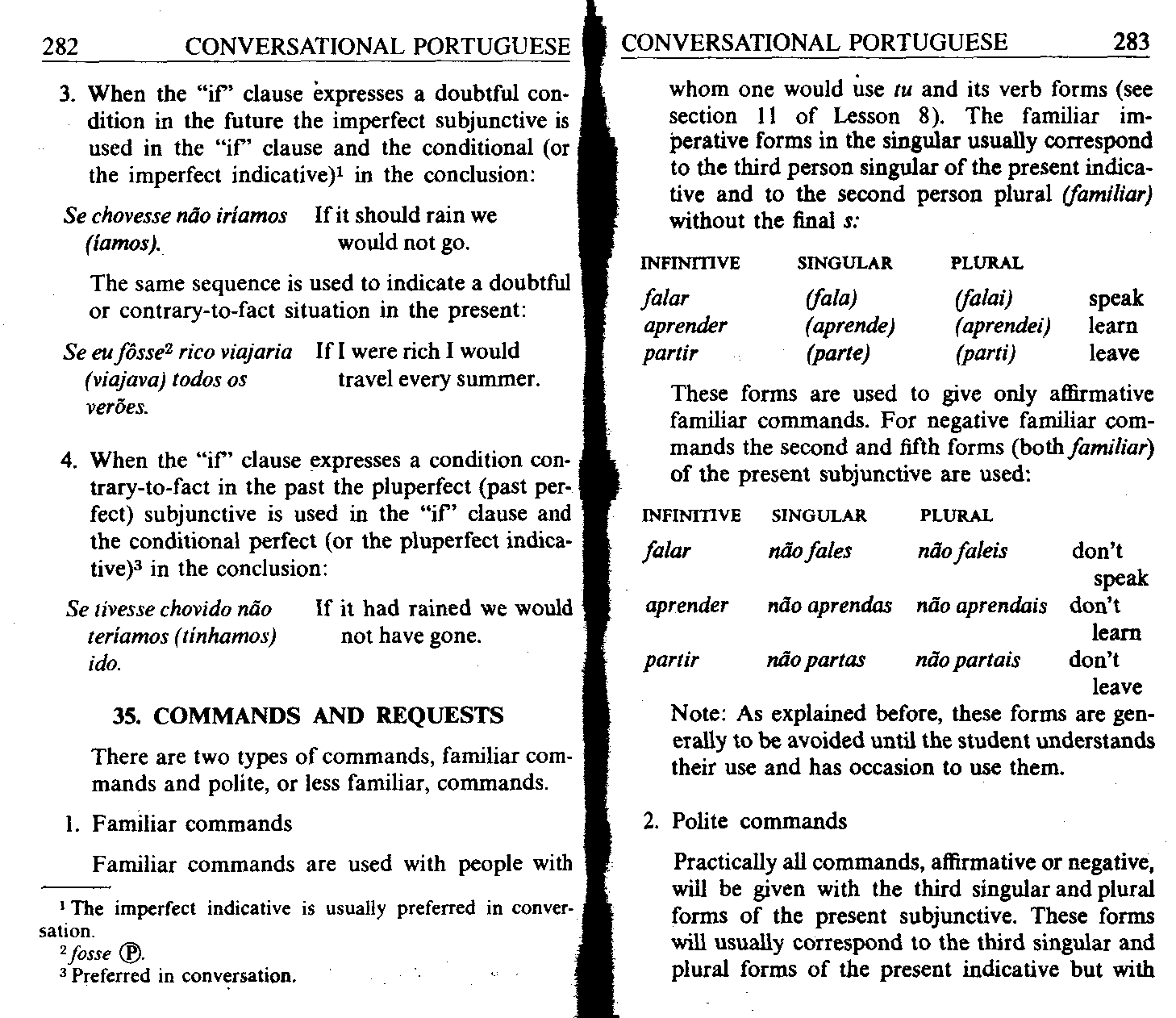Summary p282

282 CONYERSATIONAL PORTUGUESE
3. When the “if* clause expresses a doubtful con-dition in the futurę the imperfect subjunctive is used in the “if’ clause and the conditional (or the imperfect indicatWe)1 in the conclusion:
Se chovesse nao iriamos If it should rain we (iamos). would not go.
The same seąuence is used to indicate a doubtful or contrary-to-fact situation in the present:
Se eu fósse2 rico viajaria If I were rich I would (viajava) todos os travel every summer.
veroes.
4. When the “if’ clause expresses a condition con-trary-to-fact in the past the pluperfect (past per-fect) subjunctive is used in the “if’ clause and the conditional perfect (or the pluperfect indica-tive)3 in the conclusion:
Se tivesse chovido nao If it had rained we would teriamos (tinhamos) not have gone.
ido.
35. COMMANDS AND REQUESTS
There are two types of commands, familiar com-mands and polite, or less familiar, commands.
1. Familiar commands
Familiar commands are used with people with
whom one would use tu and its verb forms (see section 11 of Lesson 8). The familiar im-perative forms in the singular usually correspond to the third person singular of the present indica-tive and to the second person plural (familiar) without the finał s:
INFINmYE SINGULAR PLURAL
falar
aprender
partir
(fala) (falai) speak
(aprende) (aprendei) leam
(parte) (parti) leave
These forms are used to give only affirmative familiar commands. For negative familiar commands the second and fifth forms (both familiar) of the present subjunctive are used: 4
|
INFINITIVE |
SINGULAR |
PLURAL | |
|
falar |
nao fales |
ndo faleis |
don’t speak |
|
aprender |
nao aprendas |
nao aprendais |
don’t leam |
|
partir |
nao parias |
ndo partais |
don’t |
leave
Notę: As explained before, these forms are gen-erally to be avoided until the student understands their use and has occasion to use them.
The imperfect indicative is usuaily preferred in conver-sation.
fosse 0.
Preferred in conversation, ■
Polite commands
Practically all commands, affirmative or negative, will be given with the third singular and plural forms of the present subjunctive. These forms will usually correspond to the third singular and plural forms of the present indicative but with
Wyszukiwarka
Podobne podstrony:
Summary p240 240 CONYERSATIONAL PORTUGUESE 14. THE PLURAL 1. Nouns ending in a vowel, including na
Summary p300 300 CONYERSATIONAL PORTUGUESE cated, the change given will pertain to those forms of
Summary p230 230 CONYERSATIONAL PORTUGUESE 3, The cedilla (cedilha) is used with
Summary p234 234 CONYERSATIONAL PORTUGUESE k. with parts of the body and articles of clothing inst
Summary p236 236 CONYERSATIONAL PORTUGUESE De and em combine with the demonstrative forms (see GS2
Summary p258 258 CONYERSATIONAL PORTUGUESE 23. ADYERBS 1. Some Portuguese adverbs are formed by ad
Summary p266 266 CONYERSATIONAL PORTUGUESE27. NEGATION 1. Ndo “not” comes before
Summary p268 268 CONYERSATIONAL PORTUGUESE 2. The personal infinitiye has endings which make it ea
Summary p270 270 CONYERSATIONAL PORTUGUESE 2. to indicate a condition, or action
Summary p288 288 CONYERSATIONAL PORTUGUESE Although both forms are used, therc is a tend-ency for
Summary p292 292 CONYERSATIONAL PORTUGUESE O cafe estd frio. A janela estd aberta (fechada). Ela e
Summary p304 304 CONYERSATIONAL PORTUGUESE Some of the other verbs in -gar: apagar to put out, e
Summary p222 222 CONYERSATIONAL PORTUGUESE 21. Vamos_(to have dinner). a. jantar
Summary p224 224 CONYERSATIONAL PORTUGUESE (3) variations occur in different areas: a.
Summary p226 226 CONYERSATIONAL PORTUGUESH CONYERSATIONAL PORTUGUESE 227 d g g h j I I Ut m as d i
Summary p238 238 CONYERSATIONAL PORTUGUESE 13. MASCULINE AND FEMININE 238 CONYERSATIONAL PORTUGUES
Summary p242 242 CONYERSATIONAL PORTUGUESE seu can also be used to translate “his,” “her,” “their.
Summary p246 246 CONYERSATIONAL PORTUGUESE 1«. COMPAR1SON 1. Rcgular comparison facil easy ma
Summary p248 248 CONYERSATIONAL PORTUGUESE 19. PRONOUNS Pronouns have varying forms depending on w
więcej podobnych podstron